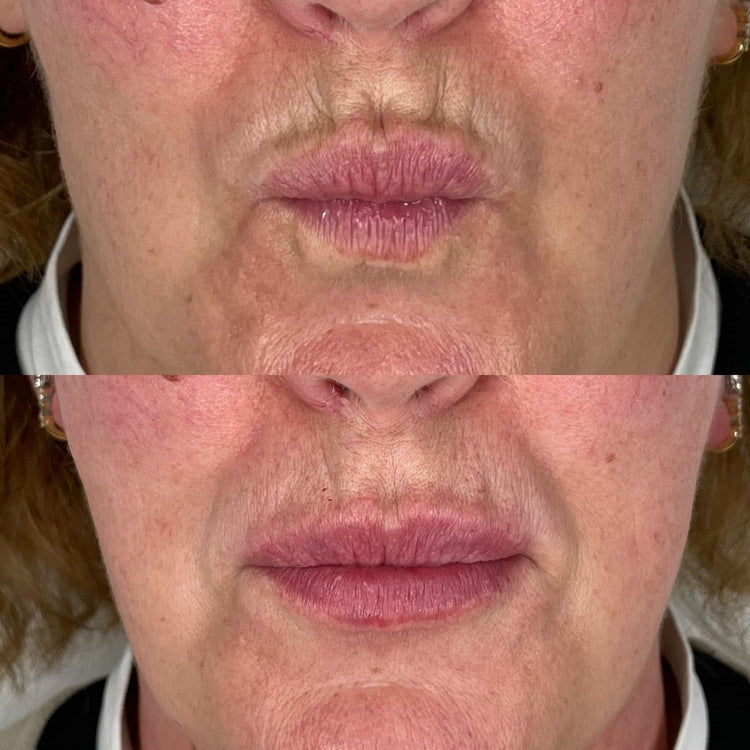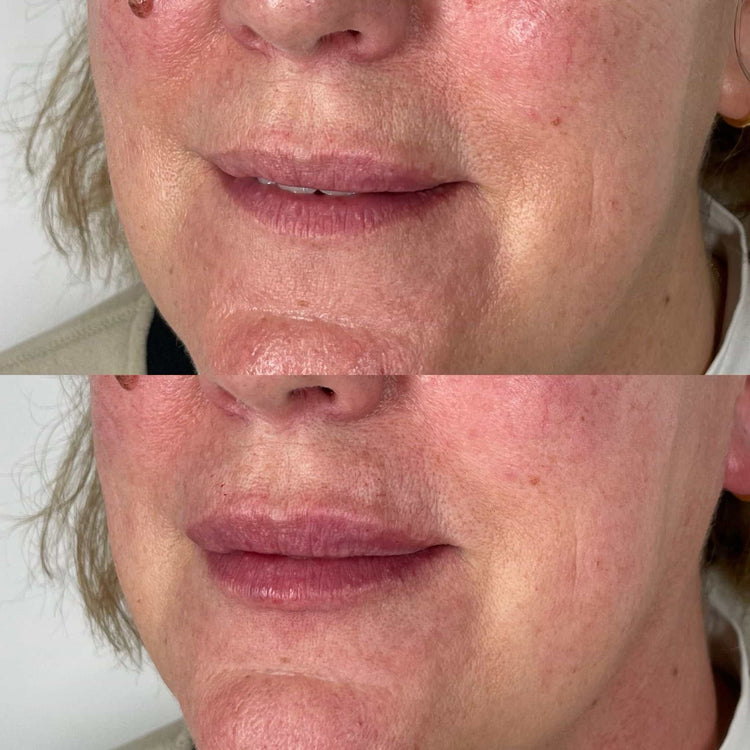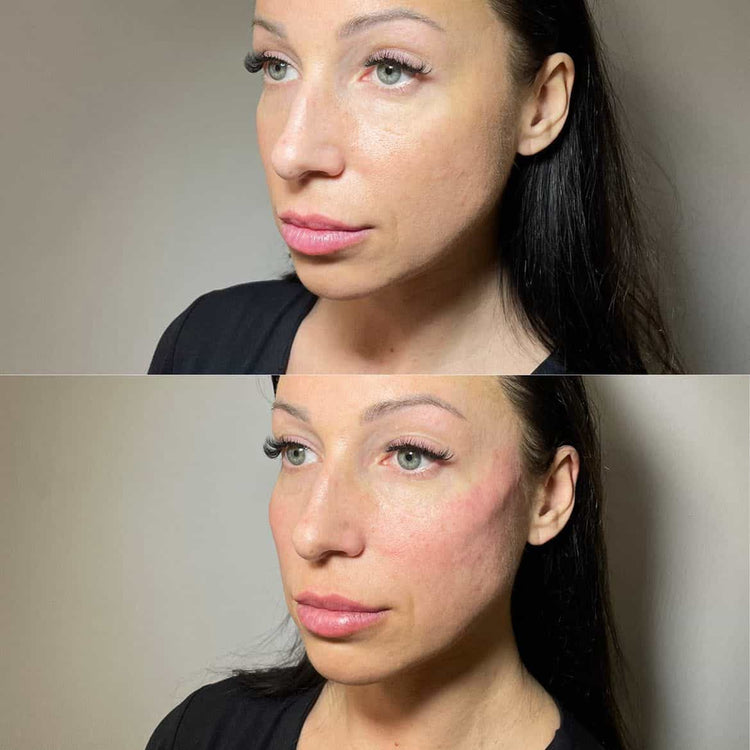Dermal Filler Types
Dermal fillers are injectable substances used to restore volume and fullness to areas of the face that have lost their youthful plumpness due to aging.
Hyaluronic Acid Fillers
Dermal fillers help restore volume in aging faces by adding substance to areas that have thinned or receded. This can help smooth out wrinkles, enhance contours, and create a more youthful appearance.
One of the most popular types of dermal fillers is hyaluronic acid (HA) fillers.
- Hyaluronic acid is a natural substance found in the body that helps to keep skin hydrated and plump.
- HA fillers are made from synthetic versions of hyaluronic acid that can be injected into the skin to add volume.
- They are typically temporary, lasting anywhere from 6 to 18 months.
Collagen Fillers
Another type of dermal filler is a collagen filler. Collagen is a structural protein found in the body that provides support and elasticity to skin.
Collagen fillers are made from either natural or synthetic collagen. Natural collagen fillers are derived from animal sources, while synthetic collagen fillers are created in a laboratory.
These fillers work by stimulating the body’s own collagen production, helping to restore volume and improve skin texture.
Poly-Lactic Acid (PLA) Fillers
Poly-Lactic Acid (PLA) fillers are another type of dermal filler that works differently than HA or collagen fillers.
- PLA fillers are made from poly-L-lactic acid, a biodegradable synthetic polymer.
- Unlike hyaluronic acid fillers, which add volume instantly, PLA fillers gradually stimulate collagen production over time.
- This gradual process results in a more natural-looking and longer-lasting volumizing effect that can last for up to 2 years or more.
How Dermal Fillers Work
Dermal fillers are non-surgical treatments used to address the visible signs of aging by restoring volume and fullness to facial areas that have lost their youthful plumpness.
Subcutaneous Injection Technique
The technique for subcutaneous injection of dermal fillers involves precisely administering the filler material beneath the skin’s surface.
A trained healthcare professional will first cleanse and numb the treatment area using a topical anesthetic to minimize any discomfort during the procedure.
Using a fine needle, they will carefully inject the dermal filler into specific layers of the subcutaneous tissue, following predetermined anatomical landmarks.
The volume of filler injected will vary depending on the individual’s needs and desired outcome, as determined by the healthcare professional during a consultation.
Following the injection, gentle pressure may be applied to the treated area to minimize bruising or swelling.
Stimulating Collagen Production
Dermal fillers work by adding volume to areas of the face that have lost fullness due to aging. They can smooth wrinkles, enhance contours, and create a more youthful appearance.
Some dermal fillers stimulate collagen production. Collagen is a protein that provides support and elasticity to skin. When these fillers are injected, they trigger the body to produce more collagen, leading to improved skin texture and volume over time.
Poly-Lactic Acid (PLA) fillers are an example of this type of filler. They gradually stimulate collagen production, resulting in a more natural-looking and longer-lasting volumizing effect.
Areas of Facial Volume Loss
As we age, our faces naturally lose volume in certain areas, leading to the appearance of wrinkles, hollows, and a loss of definition. These areas of facial volume loss can make us look older than we feel.
Cheeks
The cheeks are one area that often experiences significant volume loss as we age. The cheeks support the structure of the face, contributing to its youthful shape. As collagen and elastin production decline, the cheeks lose their fullness, leading to sunken or hollowed appearance. This can make the face look tired and gaunt.
Dermal fillers can effectively restore volume to the cheeks, reversing the signs of aging and restoring a more youthful contour.
Lips
Lips are another area that can lose volume with age. As we get older, the muscles responsible for keeping lips plump weaken, and the natural collagen and fat reserves in the lips diminish. This can lead to thin, flat lips that appear less defined.
Dermal fillers can be used to restore volume to the lips, enhancing their shape and fullness.
Jawline
Dermal fillers are non-surgical treatments used to address the visible signs of aging by restoring volume and fullness to facial areas that have lost their youthful plumpness.
Areas of the face that commonly experience volume loss include:
- Cheeks
- Lips
- Jawline
As we age, our faces naturally lose volume in certain areas, leading to the appearance of wrinkles, hollows, and a loss of definition. This can make us look older than we feel.
The cheeks are one area that often experiences significant volume loss as we age. The cheeks support the structure of the face, contributing to its youthful shape. As collagen and elastin production decline, the cheeks lose their fullness, leading to a sunken or hollowed appearance. This can make the face look tired and gaunt.
Dermal fillers can effectively restore volume to the cheeks, reversing the signs of aging and restoring a more youthful contour. Lips are another area that can lose volume with age. As we get older, the muscles responsible for keeping lips plump weaken, and the natural collagen and fat reserves in the lips diminish. This can lead to thin, flat lips that appear less defined. Dermal fillers can be used to restore volume to the lips, enhancing their shape and fullness.
The jawline is another area prone to volume loss with age. As fat pads beneath the skin shrink and muscles weaken, the jawline can become less defined, leading to a “sagging” appearance. Dermal fillers can be injected along the jawline to restore definition and create a more sculpted look.
Nose
As we age, our faces naturally lose volume in certain areas, leading to the appearance of wrinkles, hollows, and a loss of definition. This can make us look older than we feel.
The nose is one area that can experience subtle changes due to volume loss with age.
As collagen and fat reserves diminish, the tip of the nose may appear more pointed or narrow. The bridge of the nose might also appear slightly less prominent.
Dermal fillers can be used to address these age-related changes by subtly adding volume to the nose.
Under-Eyes (Tear Troughs)
Dermal fillers are non-surgical treatments used to address the visible signs of aging by restoring volume and fullness to facial areas that have lost their youthful plumpness.

As we age, our faces naturally lose volume in certain areas, leading to the appearance of wrinkles, hollows, and a loss of definition. This can make us look older than we feel.
One particularly noticeable area of facial volume loss is under the eyes (tear troughs).
- As collagen production decreases, the skin under the eyes thins and loses its ability to plumply fill out the contour.
- This can create a shadowing effect, making the area appear darker and accentuating wrinkles.
Dermal fillers can be used to effectively address tear trough volume loss.
By injecting filler into the tear trough area, the hollows can be filled in, smoothing out the under-eye appearance and reducing the appearance of shadows.
Benefits of Dermal Fillers for Rejuvenation
Facial aging is often characterized by a gradual loss of volume, leading to wrinkles, hollows, and a less youthful appearance. Dermal fillers offer a non-surgical solution to restore this lost volume, helping individuals achieve a more refreshed and revitalized look.
Improved Facial Contour and Symmetry
Dermal fillers are injectable substances used to restore volume and fullness to areas of the face that have lost their youthful plumpness due to aging.
Dermal fillers help restore volume in aging faces by adding substance to areas that have thinned or receded. This can help smooth out wrinkles, enhance contours, and create a more youthful appearance.
One of the most popular types of dermal fillers is hyaluronic acid (HA) fillers.
- Hyaluronic acid is a natural substance found in the body that helps to keep skin hydrated and plump.
- HA fillers are made from synthetic versions of hyaluronic acid that can be injected into the skin to add volume.
- They are typically temporary, lasting anywhere from 6 to 18 months.
Another type of dermal filler is a collagen filler. Collagen is a structural protein found in the body that provides support and elasticity to skin.
Collagen fillers are made from either natural or synthetic collagen. Natural collagen fillers are derived from animal sources, while synthetic collagen fillers are created in a laboratory.
These fillers work by stimulating the body’s own collagen production, helping to restore volume and improve skin texture.
Poly-Lactic Acid (PLA) fillers are another type of dermal filler that works differently than HA or collagen fillers.

- PLA fillers are made from poly-L-lactic acid, a biodegradable synthetic polymer.
- Unlike hyaluronic acid fillers, which add volume instantly, PLA fillers gradually stimulate collagen production over time.
- This gradual process results in a more natural-looking and longer-lasting volumizing effect that can last for up to 2 years or more.
Dermal fillers are non-surgical treatments used to address the visible signs of aging by restoring volume and fullness to facial areas that have lost their youthful plumpness.
Areas of the face that commonly experience volume loss include:
- Cheeks
- Lips
- Jawline
As we age, our faces naturally lose volume in certain areas, leading to the appearance of wrinkles, hollows, and a loss of definition. This can make us look older than we feel.
Facial aging is often characterized by a gradual loss of volume, leading to wrinkles, hollows, and a less youthful appearance. Dermal fillers offer a non-surgical solution to restore this lost volume, helping individuals achieve a more refreshed and revitalized look.
Minimized Wrinkles and Fine Lines
Dermal fillers are injectable substances used to restore volume and fullness to areas of the face that have lost their youthful plumpness due to aging.
One of the most popular types of dermal fillers is hyaluronic acid (HA) fillers.
- Hyaluronic acid is a natural substance found in the body that helps to keep skin hydrated and plump.
- HA fillers are made from synthetic versions of hyaluronic acid that can be injected into the skin to add volume.
- They are typically temporary, lasting anywhere from 6 to 18 months.
Another type of dermal filler is a collagen filler. Collagen is a structural protein found in the body that provides support and elasticity to skin.
Collagen fillers are made from either natural or synthetic collagen. Natural collagen fillers are derived from animal sources, while synthetic collagen fillers are created in a laboratory.
These fillers work by stimulating the body’s own collagen production, helping to restore volume and improve skin texture.
Poly-Lactic Acid (PLA) fillers are another type of dermal filler that works differently than HA or collagen fillers.
- PLA fillers are made from poly-L-lactic acid, a biodegradable synthetic polymer.
- Unlike hyaluronic acid fillers, which add volume instantly, PLA fillers gradually stimulate collagen production over time.
- This gradual process results in a more natural-looking and longer-lasting volumizing effect that can last for up to 2 years or more.
Areas of the face that commonly experience volume loss include:
- Cheeks
- Lips
- Jawline
Facial aging is often characterized by a gradual loss of volume, leading to wrinkles, hollows, and a less youthful appearance. Dermal fillers offer a non-surgical solution to restore this lost volume, helping individuals achieve a more refreshed and revitalized look.
Enhanced Facial Features
Dermal fillers are a popular non-surgical treatment for addressing the visible signs of aging by restoring volume and fullness to areas of the face that have lost their youthful plumpness. They work by injecting gel-like substances beneath the skin’s surface, effectively filling in wrinkles, smoothing contours, and enhancing facial features.
One of the main benefits of dermal fillers is their ability to restore lost volume. As we age, our bodies produce less collagen and elastin, leading to a gradual loss of fullness in areas like the cheeks, lips, and under the eyes. Dermal fillers can counteract this process by adding volume to these areas, restoring a more youthful appearance.
Dermal fillers are also effective in smoothing wrinkles and fine lines. By filling in the space between wrinkles, they create a smoother, more even complexion. This can significantly minimize the appearance of age lines around the mouth, eyes, and forehead.
Beyond addressing visible signs of aging, dermal fillers can enhance facial features. They can add fullness to thin lips, define the jawline, and elevate the cheekbones, creating a more sculpted and balanced facial profile.
Furthermore, many types of dermal fillers stimulate collagen production within the skin. This natural process helps to maintain long-term results by encouraging the body to produce its own collagen, leading to improved skin texture and firmness over time.
Considerations and Risks
While dermal fillers offer numerous benefits for restoring a youthful appearance, it is essential to consider potential risks and complications associated with this procedure. As with any medical treatment, there are potential side effects that should be discussed with a qualified healthcare professional before undergoing dermal filler injections.
Common side effects of dermal fillers can include redness, swelling, bruising, tenderness, itching, or discomfort at the injection site. These side effects are usually temporary and subside within a few days to a week.
In rare cases, more serious complications may occur, such as an allergic reaction, infection, or vascular occlusion (blockage of blood vessels).
Allergic Reactions
Dermal fillers can effectively restore volume to areas like the cheeks, lips, and jawline, resulting in a smoother, more youthful appearance.
However, it’s essential to be aware of potential risks and complications associated with dermal filler treatments.
- Allergic Reactions: Some individuals may experience allergic reactions to certain components within the filler material. This can manifest as itching, redness, swelling, or in severe cases, anaphylaxis.
- Infection: As with any injection procedure, there is a risk of infection at the injection site. Proper sterilization techniques and post-procedure care are crucial to minimize this risk.
- Vascular Occlusion: This rare but serious complication involves blockage of blood vessels by the filler, potentially leading to tissue damage or necrosis (cell death). It’s vital that the injector has extensive experience and knowledge to avoid this risk.
- Lumps or Nodules: Filler may not always be evenly distributed, resulting in visible lumps or nodules beneath the skin.
It is important to choose a qualified and experienced healthcare professional who is knowledgeable about dermal fillers and can assess your individual needs and medical history to determine the safest and most effective treatment approach. A thorough consultation will help you understand the potential risks and benefits, allowing you to make an informed decision about whether dermal fillers are right for you.
Infection Risk
While dermal fillers offer a minimally invasive approach to rejuvenating the face, it’s crucial to understand potential risks and complications associated with this procedure.
Infection Risk: As with any injection procedure, there is an inherent risk of infection at the injection site. This risk can be minimized by ensuring that the healthcare professional uses sterile techniques and proper protocols for handling the filler material and equipment.
To further reduce infection risk:
- Follow post-procedure instructions carefully, including keeping the treated area clean and avoiding touching or picking at it.
- Report any signs of infection (redness, swelling, pain, pus, or fever) to your healthcare professional immediately.
Other potential risks associated with dermal fillers include allergic reactions, vascular occlusion (blockage of blood vessels), and the formation of lumps or nodules. These complications are generally rare but highlight the importance of selecting a qualified and experienced injector who will carefully assess your individual needs and medical history before administering the treatment.
Always have a thorough consultation with your healthcare professional to discuss potential risks, benefits, and alternative treatment options before undergoing any dermal filler procedure.
Lumping or Migration of Filler Material
Dermal fillers offer numerous benefits for restoring a youthful appearance, but it’s essential to be aware of potential risks and complications.
Here are some considerations:
* **Lumping or Migration:** Dermal filler material can sometimes clump together or migrate from the intended injection site. This can result in an uneven or unnatural appearance. Careful injector technique and choosing the right type of filler for each area can help minimize this risk.
* **Allergic Reactions:** Some individuals may experience allergic reactions to components in dermal fillers. These can range from mild (redness, itching) to severe (anaphylaxis). A thorough medical history review and potential patch test before treatment is crucial.
* **Infection:** As with any injection procedure, there’s a risk of infection at the injection site. Proper sterilization techniques and post-procedure care are essential to minimize this risk.
* **Vascular Occlusion:** This rare but serious complication involves blockage of blood vessels by the filler, potentially leading to tissue damage or necrosis (cell death). It is essential to choose an experienced injector who understands how to avoid this risk.
Choosing a Qualified Provider
Choosing a qualified provider is crucial for ensuring safe and effective results with dermal fillers. Look for a board-certified dermatologist, plastic surgeon, or licensed medical practitioner with extensive experience in administering dermal fillers. Inquire about their training, qualifications, and the types of dermal fillers they use.
Reading online reviews and asking for recommendations from friends or family can also help you find a reputable provider. Remember to schedule a consultation to discuss your goals, medical history, and any concerns you may have. A qualified provider will listen attentively to your needs and develop a personalized treatment plan tailored to your specific requirements.
Expertise in Facial Aesthetics
Choosing a qualified provider is essential when considering dermal fillers for facial rejuvenation.
Here’s what to look for:
* **Board Certification:** Seek out a board-certified dermatologist, plastic surgeon, or otolaryngologist (ENT) who specializes in aesthetic medicine. This certification ensures they have met rigorous education and training standards.
* **Experience with Dermal Fillers:** Inquire about the provider’s experience specifically with dermal fillers. Ask how many treatments they perform annually and which types of fillers they are most proficient with.
* **Training and Qualifications:** A reputable provider will be transparent about their training and certifications related to dermal filler administration. They may hold additional credentials or memberships in professional organizations dedicated to aesthetic medicine.
* **Consultation Process:** A thorough consultation is crucial. The provider should take the time to understand your goals, medical history, and any concerns you have. They should also explain the procedure in detail, including potential risks and benefits, and answer all your questions thoroughly.
* **Facility and Sterilization Practices:** Ensure the clinic or practice has a clean, comfortable environment and adheres to strict sterilization protocols to minimize infection risk.
Don’t hesitate to ask for before-and-after photos of previous patients to get an idea of the provider’s aesthetic style and the types of results they achieve. Trust your instincts – if you feel uncomfortable or uncertain about a provider, it’s okay to seek a second opinion.
Consultation and Treatment Planning
## Choosing a Qualified Provider, Consultation, and Treatment Planning for Dermal Fillers
This guide will walk you through choosing the right provider for dermal fillers, understanding the consultation process, and planning your treatment effectively.
### Finding the Right Practitioner
Selecting a qualified provider is paramount for ensuring safe and successful dermal filler treatments. Look for these key qualities:
* **Board Certification:** Choose a board-certified dermatologist, plastic surgeon, or otolaryngologist (ENT) with expertise in aesthetic medicine. Board certification signifies they’ve met rigorous training and ethical standards.
* **Dermal Filler Expertise:** Inquire about the provider’s experience specifically with dermal fillers. Ask how many treatments they perform annually and which types of fillers they specialize in.
* **Comprehensive Training:** A reputable provider will be transparent about their training related to dermal filler administration. They might hold additional certifications or memberships in aesthetic medicine organizations.
**Don’t hesitate to ask for references or see before-and-after photos of previous patients.** This helps gauge the provider’s aesthetic style and understand the types of results they achieve.
### The Consultation: Your Pathway to Personalized Care
A thorough consultation is crucial for establishing your treatment plan. Here’s what you can expect:
* **Detailed Discussion:** The provider will ask about your goals, medical history, previous treatments (including cosmetic procedures), and any concerns or allergies you have.
* **Assessment and Evaluation:** They’ll examine your facial anatomy to determine the best areas for filler placement and assess the amount needed based on your desired outcome.
* **Filler Recommendations:** The provider will explain different types of fillers available and recommend the most suitable option based on your individual needs and skin type.
* **Realistic Expectations:** They’ll discuss realistic outcomes, potential risks (allergic reactions, bruising, swelling), and aftercare instructions.
### Planning Your Treatment
After the consultation, you can work with your provider to create a personalized treatment plan:
* **Treatment Plan Outline:** This will include the type of filler used, the amount needed, injection sites, expected results, and potential downtime.
* **Scheduling Appointments:** Depending on the desired outcome and area being treated, multiple sessions might be necessary.

* **Pre-Treatment Instructions:** You’ll receive instructions to prepare for your appointment (avoiding certain medications or activities).
* **Aftercare Guidelines:** Post-treatment care is essential for optimal healing and results. The provider will provide specific instructions on managing any swelling, redness, or other side effects.
Remember, choosing a qualified provider and having a thorough consultation are essential steps in ensuring safe and effective dermal filler treatments.
- How Much Does Swelling Go Down After Lip Filler - May 22, 2025
- Skin Injectables Near Chiddingfold, Surrey - May 22, 2025
- Juvederm Volite Skin Booster Treatments Near Cheam, Surrey - May 21, 2025
